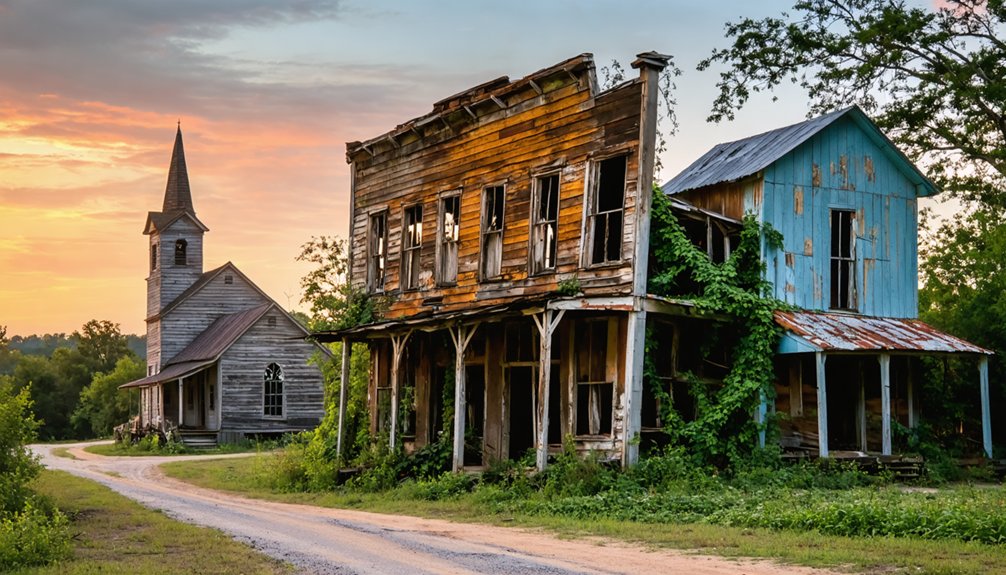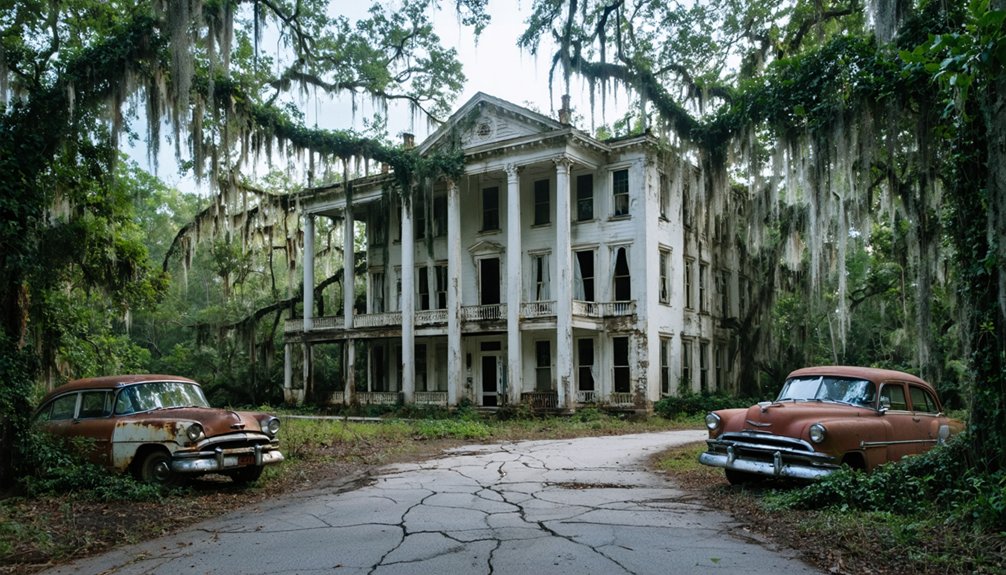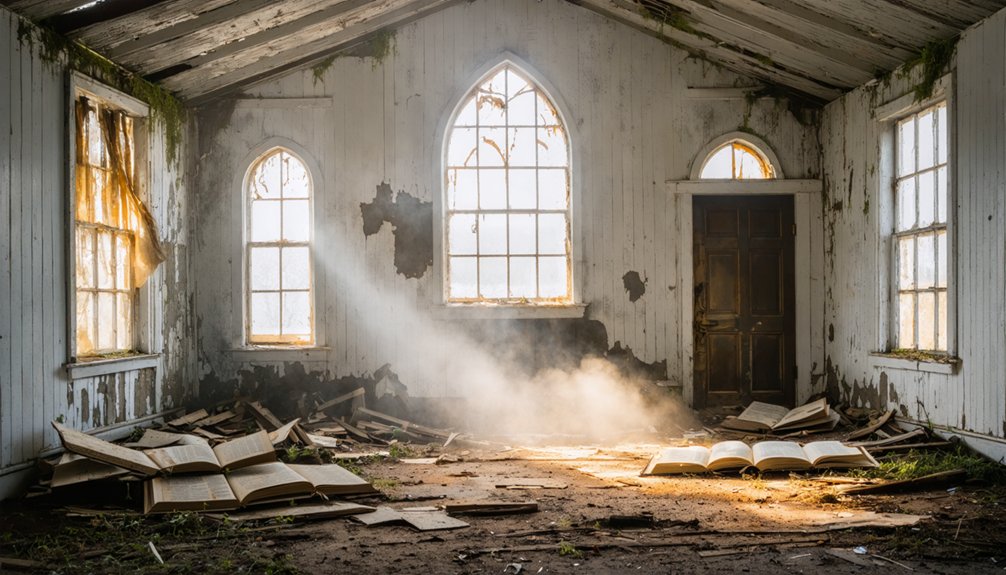Explore the South’s forgotten settlements, including Gleeson and Ruby in Arizona, where copper mining remnants tell tales of frontier life. In Texas, Terlingua’s mercury mining heritage stands against the Chihuahuan Desert backdrop. Ellenton, South Carolina offers glimpses of a town erased by government intervention, while Georgia’s Auraria preserves America’s first gold rush history. These abandoned communities offer windows into boom-and-bust cycles that shaped the American landscape.
Key Takeaways
- Gleeson, Arizona offers authentic Wild West ruins including a concrete jail, saloon remnants, and mining equipment.
- Ruby, Arizona features over 25 preserved structures and colorful local legends, accessible for a fee via maintained dirt roads.
- Terlingua, Texas showcases mercury mining history near Big Bend National Park with ruins and a historic cemetery.
- Ellenton, South Carolina presents a unique government-erased town with occasional Department of Energy tours available.
- Auraria, Georgia contains remnants of America’s first gold rush, predating California’s famous gold discovery by two decades.
Gleeson, Arizona: Where the Old West Still Stands
Nestled in the rugged terrain of southeastern Arizona, Gleeson stands as a tribute to the boom-and-bust cycle that characterized Western mining towns in the early 20th century.
Originally settled as Turquoise in 1890, the area transformed when John Gleeson discovered copper in 1900, establishing the Copper Belle Mine that would sustain a community of 500 souls.
As you explore this authentic ghost town, you’ll encounter the concrete jail built in 1910, remnants of Joe Bono’s Saloon, and the old post office—structures that survived the devastating 1912 fire.
Mining heritage is evident in the scattered tailings and equipment that pepper the landscape. At its peak, the town’s population reached over 1,000 residents drawn by the lucrative copper mining industry. The Gleeson cemetery, located west of town, offers visitors a solemn glimpse into the lives of those who once called this frontier community home.
The town’s final chapter closed when mines ceased operations in 1958, leaving behind this remarkable time capsule of frontier life.
Ruby, Arizona: The Best-Preserved Mining Legacy Near the Border
Located just a stone’s throw from the Mexican border in Santa Cruz County, Ruby stands as Arizona’s crown jewel of ghost town preservation, offering visitors an unparalleled glimpse into the state’s mining heritage.
Ruby’s history as Montana Camp began in the 1870s before becoming Arizona’s leading lead and zinc producer in the 1930s, hosting up to 2,000 residents who enjoyed electricity, running water, and community facilities. The Eagle-Picher Lead Company transformed the town with 15-mile water pipelines that supplied these modern amenities.
From humble desert settlement to thriving mining epicenter, Ruby’s evolution reflects Arizona’s pioneering industrial spirit.
Ruby architecture impresses with over 25 standing structures, making it exceptionally well-preserved despite decades of abandonment. Local Ruby legends include tales of curses and double homicides at the mercantile, adding a haunting dimension to your explorations. The restored Ruby Schoolhouse stands as a poignant reminder of the once-thriving community that called this mining town home.
Ruby tourism requires preparation—a maintained dirt road leads to this privately-owned site where you’ll pay an entry fee to experience one of the Southwest’s most authentic mining communities.
Terlingua, Texas: Mercury Mining Memories in the Desert
Situated in the stark Chihuahuan Desert near Big Bend National Park, Terlingua stands as a tribute to Texas’s forgotten mercury mining era, where fortune and failure intertwined amid harsh desert conditions.
Chicago industrialist Howard Perry transformed this desolate landscape into America’s leading mercury producer when he established the Chisos Mining Company in 1903.
As you explore this ghost town, you’ll notice limestone ruins that once housed 2,000 residents during the 1910s-1920s boom years. The vibrant community featured a unique cultural blend of Mexican and American traditions. During World War I, demand for mercury skyrocketed, generating daily profits averaging $2,000. The cemetery, dating back to 1902, silently chronicles mining accidents and the devastating 1918 influenza outbreak.
While walking these grounds, remember you’re treading above 23 miles of underground tunnels.
The mining operation that extracted valuable cinnabar ore for military explosives eventually collapsed into bankruptcy in 1942, leaving behind this hauntingly beautiful monument to American industrial ambition.
Ellenton, South Carolina: The Town That Government Erased
Unlike most ghost towns that faded through economic decline, Ellenton, South Carolina met its end through deliberate government action when Cold War priorities transformed an entire community into a casualty of national security.
Founded in 1870 and once home to 760 residents, Ellenton’s history ended abruptly in 1952 when the federal government seized 210,000 acres for the Savannah River Plant‘s hydrogen bomb production.
You’ll find almost nothing remains of the original town today—just scattered foundations and memories preserved through annual reunions of displaced families. The nearby communities of Dunbarton and Meyers Mill suffered the same fate during this massive evacuation.
Though New Ellenton was established nearby, it never recaptured the original community’s character. The pattern of government displacement mirrors what happened to Picher, Oklahoma where residents were forced to relocate due to environmental hazards.
Access remains highly restricted, with only occasional Department of Energy tours allowing glimpses of America’s stark example of government displacement during Cold War urgency.
Auraria, Georgia: Gold Rush Remnants in Southern Appalachia
While Ellenton’s demise came from government decree, our next ghost town offers a glimpse into America’s earliest gold fever. Auraria, Georgia, established in 1832, predated California’s famous rush by nearly two decades, making it one of America’s first gold mining communities—and possibly its first true ghost town.
Originally called Deans, then Nuckollsville, Auraria (Latin for “gold”) flourished briefly with a population reaching 1,000. The town originated after Benjamin Parks discovered a gold nugget while tracking deer in North Georgia woods on his birthday in 1828. The bustling town featured taverns, stage lines, and a newspaper, epitomizing frontier freedom.
Yet by 1833, when nearby Dahlonega secured the county seat, Auraria’s decline began. Western gold rushes lured miners away, and by the early 20th century, this once-vibrant community stood abandoned. The area surrounding Auraria yielded over $20 million in gold during its active mining period.
Today, near Dahlonega, you’ll find only scattered remnants marking where America’s southern gold dream first took hold.
Frequently Asked Questions
Are These Ghost Towns Safe to Visit Alone?
Like walking a tightrope without a net, solo exploration of these ghost towns carries significant risks. You’re safer visiting with companions, following safety tips, and researching locations thoroughly beforehand.
Can You Legally Take Artifacts From These Abandoned Sites?
No, you can’t legally remove artifacts without proper permits. Artifact preservation requires leaving items in place, and unauthorized collection carries serious legal implications including fines and potential imprisonment.
What’s the Best Season to Photograph These Ghost Towns?
Fall offers ideal conditions for ghost town photography. You’ll capture autumn colors against weathered structures while enjoying reduced humidity and fewer tourists. Winter landscapes reveal architectural details normally hidden by vegetation.
Are Any of These Locations Considered Haunted or Paranormally Active?
All four towns harbor profound haunted histories. You’ll encounter paranormal legends at Cahawba (Colonel Pegues’ orb), Blakeley (fort apparitions), Claiborne (disease-related specters), and Prairie Bluff (cemetery manifestations)—each offering distinctive supernatural narratives.
Do You Need Special Permits to Explore These Sites?
Most sites on public lands allow casual visitation, but you’ll need permits for activities disturbing historical artifacts. Private ghost towns require owner permission—research exploration guidelines beforehand to respect each location’s historical significance.
References
- https://www.visittucson.org/blog/post/8-ghost-towns-of-southern-arizona/
- https://en.wikipedia.org/wiki/Wikipedia:WikiProject_Ghost_towns
- https://styleblueprint.com/everyday/ghost-towns-in-the-south/
- https://freepages.rootsweb.com/~gtusa/history/
- https://www.mythfolks.com/haunted-us-ghost-towns
- https://www.youtube.com/watch?v=fPqYTIxEM3w
- https://www.visitutah.com/things-to-do/history-culture/ghost-towns
- https://m.dresshead.com/files/scholarship/Documents/Ghost_Towns_Lost_Cities_Of_The_Old_West_Shire_Usa.pdf
- https://www.geotab.com/ghost-towns/
- https://noospheregeologic.com/blog/tag/ghost-towns/



